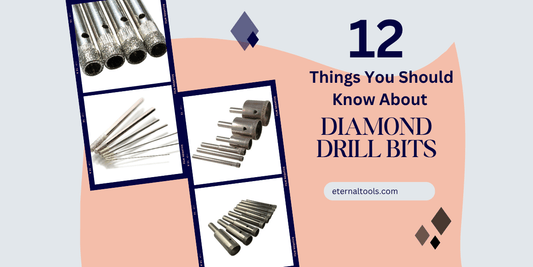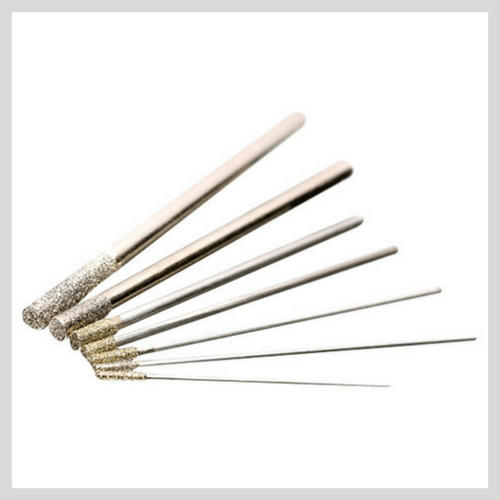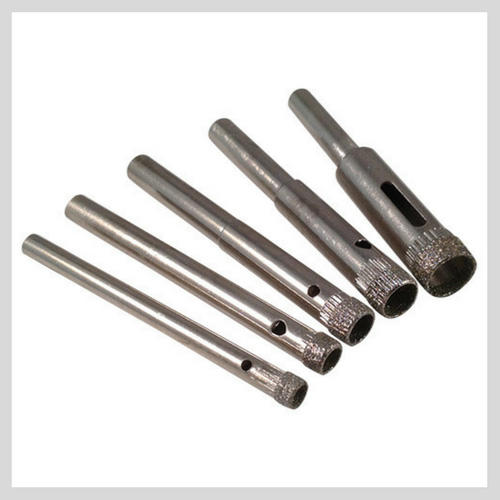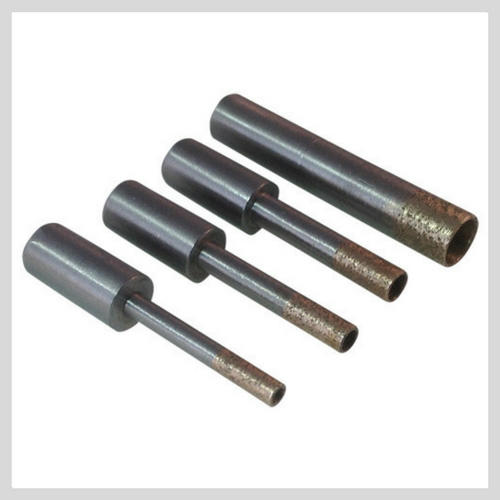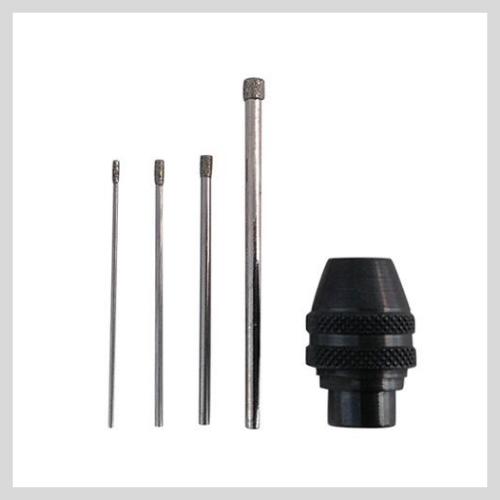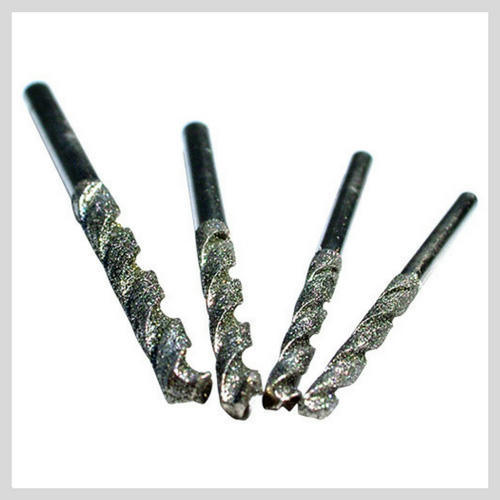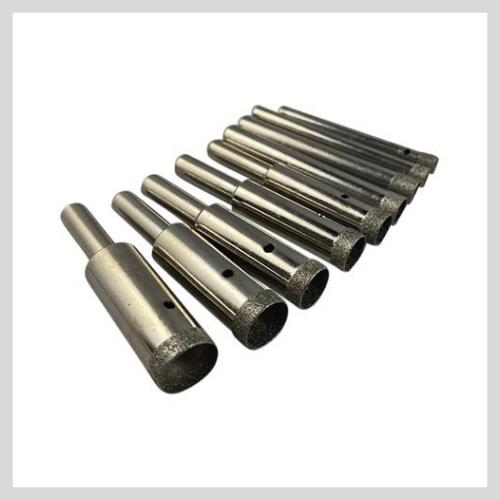1. What are Diamond Drill Bits used for?
Diamond drill bits are perfect for drilling holes through hard materials such as these:
- Glass, sea glass, beach glass, fused glass, sheet glass
- Stone, gemstones, rock, pebbles, minerals
- Ceramic, porcelain, tiles, glazed pottery, plates, china
- Shell, antler, bone, fossil
- Hard composite materials
- Very hard woods
For precise holes in jewellery, fused glass or porcelain, opt for our micro diamond-tipped drill bits with a solid tip. These are perfect when working with tough materials like sea glass or gemstones and are available in sizes as small as 0.75mm.
DO NOT use diamond drill bits on metal, soft wood, plaster or soft plastic. These materials are too soft and can cause the diamonds on your drill bit to clog up. A diamond drill and all diamond tools are for use on harder materials. When drilling holes in soft metals, plastics and wood, use High Speed Steel drill bits (HSS) and for drilling holes in hard metals, use a solid carbide twist drill or Carbide Drill Bits.
Diamond is the hardest material, and therefore anything else can be cut or drilled with it. If you are cutting or drilling through very hard materials, such as Sapphire or Quartz, then bear in mind you will need a lot of patience and perhaps more drill bits than you would if you were drilling a hole through glass or Opal.
A common mistake is made when diamond cylinder burrs or diamond rods are used instead of diamond drill bits. They look very similar, but they are manufactured for very different tasks (carving, grinding and engraving) and, therefore, won't have the same cutting abilities or longevity.
2. What Are Diamond Core Drills?
Diamond core drills are hollow.
As with all diamond drill bits, use water as both a lubricant and a coolant. A hollow drill allows water to flow up inside and around the inner core of these drill bits as you drill, helping to keep the drill bit cool and removing debris.
Diamond core drills are available in sizes 1mm - 3mm and 3.5mm - 60mm and larger.
For drilling tiny holes in plates, glass, fused glass and for thin pieces of sea glass, we recommend using a small diamond core drill. These are available in sizes ranging from 1mm to 3mm.
Are you a Beginner or working with delicate materials? Our hollow drill bits for jewellery are ideal for beginners or anyone working with glass, plates, or ceramics.
Diamond Core bits also come in a range with a 2.35mm shank
As you drill, the water swirls around inside the core. This helps prolong the life of your drill bit and prevents cracking or shattering of the material being drilled.
Small Diamond Drill Bits or Small Diamond Core Drills: Which Should I Use?
Micro diamond-tipped drill bits (solid end) are more robust and ideal for tougher jobs – think thick sea glass, dense gemstones, or fossils. They last longer due to a greater diamond surface area, but may take a little longer to cut through.
Small hollow core bits are faster cutters, but are best reserved for softer materials, such as tiles, glass, or beach pottery. They're ideal when speed matters more than lifespan.
Diamond coring drills are ideal for drilling through various materials, including glass, sea glass, pebbles, stone, slate, ceramic, plates, and shells. They are the best drill bits for rock, DIY, and craft projects, as well as for professional tradesmen.
Diamond drills for drilling of all types of ceramic tile are essential, and will drill holes far more easily and with a smoother cut than any other tile drill bits.
If you're a regular user of diamond drill bits, it's worth having a combination of both small diamond drill bits and small diamond core drills in your toolbox, as you may not know the material's toughness until you start drilling.
| Tool | Best For | Hole Size | Speed | Lifespan |
|---|---|---|---|---|
| Solid Diamond Bits | Gemstones, tough sea glass, fossils | 0.75–3mm | 5,000–10,000 RPM | High |
| Core Bits | Glass, plates, ceramic, beginner use | 1–3mm | Slow | Medium |
Debris stuck inside the core?
Drilling in an up-and-down motion allows water to swirl around inside the core of the drill bit, creating space for debris to fall out.
However, if you already have debris stuck inside the centre of your drill and need to dislodge it, you can try a few of these things:
- Drill your next piece of material, and this usually dislodges it.
- Use a wire brush to dislodge the stubborn core.
- Each core drill, from sizes 3mm and upwards, either has a hole on one side or is hollow all the way through the drill bit. Push a pin through the hole or the end to try to dislodge the core.
Water is an ideal lubricant to use when drilling. There are oil-based lubricants available, but it's not necessary to incur the expense of purchasing them. We've tried and tested many over the years, and water is still the winner!
Drilling partway into your material, but don't want to go all the way through?
This is known as a blind hole.
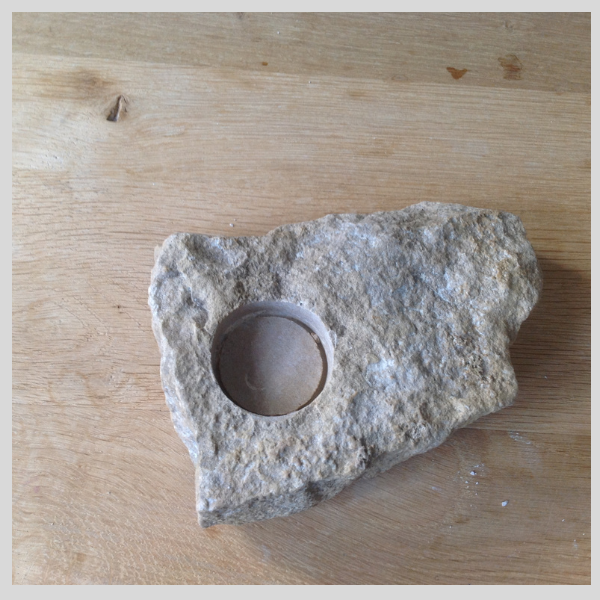
If you are looking to create a slate or stone candle holder, you will need to use a diamond core drill and drill only partway through your material, rather than making a hole. This is called a 'Blind Hole'
To do this, have a read of our article ' How to Make A Beautiful Stone Tea Light Candle Holder in 4 Easy Steps'
If you are looking to insert an object, such as a bead or gemstone, into your material and require the bead to sit flush in the stone, then it is better to use a diamond core drill that is slightly smaller in diameter than the hole you wish to make. You can then grind away the edges with a diamond burr so that your bead sits flush in the hole.
Bottle Neck Diamond Core Drills with a 2.35mm shank (3/32")
Normally, the shank (the end that goes into your drill, not the diamond working end) on larger-sized core drills (4mm and upwards) is too big to fit into a hobby-type rotary tool such as a Dremel. This means using a large, heavy-duty, regular household drill.
However, Bottle Neck Diamond Core drills, as seen below, are larger-sized 6mm core drills, but with a shank that fits into your pendant drill, Dremel, or Foredom-type drill.
Multi-Purpose Diamond Drills Bits are solid bits (so, no core) and these also have a 2.35mm shank (3.32"). These are available in sizes: 1.20mm, 1.5mm, 1.80mm, 2.10mm and 2.60mm
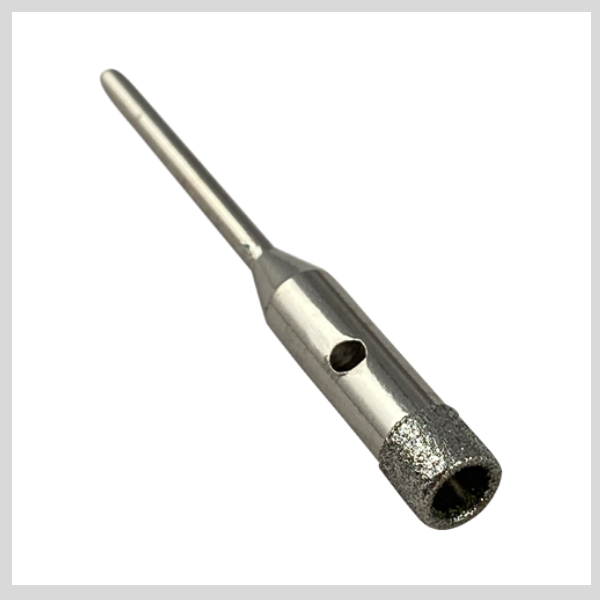
"I love this tool - it makes it so easy to drill a hole in ceramic and is one of my most used tools"
3. What is the difference between sintered and electroplated or coated diamond drill bits and burrs?
Electroplated or coated diamonds are bonded to the drill bit using nickel in a single layer, and although they won’t last as long as sintered diamonds, they are a cheaper alternative.
Sintered diamond drill bits feature diamond grit bonded to the matrix at very high temperatures, resulting in multiple layers of diamonds. By dressing or cleaning with an aluminium oxide stone, the drill bit or burr can be maintained, revealing a new layer of diamonds each time.
Electroplated, or coated, diamond drill bits, as they're more commonly referred to, indicate that the diamonds are coated onto the steel shank in a single layer; therefore, once this layer has worn away, the drill bit will need to be replaced. These are the most economical and popular types of drill bits.
Sintered diamond core drills and Sintered burrs have several layers of diamonds and therefore last a very long time but will also be more expensive than coated diamond drill bits.
Sintered diamond bits require cleaning or dressing before use and after each use with an aluminium oxide stone, thus revealing a fresh layer of diamonds each time.
Sintered core drills are popular among stone masons, while sculptors, glass engravers, and stone carvers use sintered burs.
4. How Long Does a Diamond Drill Bit Last? And How Many Holes Will One Drill Bit Make?
The lifetime of your diamond tip drill bits depends on several factors, including the proper drill speed, lubricant, pressure, and the density of the material being used.
Unfortunately, this is a 'How-Long-Is-A-Piece-Of-String' type of question, as we have no way of knowing what components make up your material.
If you're drilling through sea glass, for instance, these may be thousands of years old, and we don't know the source of the glass. That said, some have achieved more than 250 holes in sea glass from just one bit!
The same applies to drilling holes in china plates. We can estimate that you may be able to drill 15 holes with one drill bit, possibly more, but it's difficult to know for certain.
Refer to a chart of the Mohs Mineral Scale of Hardness to compare the hardness of different materials. Be aware that drilling through hard gemstones can be a time-consuming process, so be patient; you'll get there in the end.
If you're drilling through pebbles, they can often be composed of various minerals, and some pebbles have flint or quartz flecks. These will be incredibly tough to drill through, so when selecting your beach pebbles, try to choose stones without any white or speckled bits. More on drilling through pebbles can be found in our article 'How To Drill Pebbles.'
To gain the maximum life from your drill bit and to prevent your material from cracking, ensure you use little to no pressure, keep the speed on the slowest setting of your drill and always keep your material and drill bit cool with plenty of water.
5. How Do I Attach Diamond Drill Bits to My Drill? Will They Fit My Drill?
Very small diamond drill bits ranging in sizes between 0.75mm - 3mm won't fit into a rotary drill or DIY drill without the appropriate collet or chuck to hold them.
Dremel offers a couple of attachments which will fit your drill: The Dremel Collet Nut Kit and the Dremel Multi Chuck.
A set like the Diamond Drill Bits Set for your Dremel Tool includes the Dremel multi-chuck along with two small diamond drill bits and two small core drills - well worth it if you're just starting out and want to test both types of diamond drill bits.
Roughly half of the diamond tip drill bit shank should be visible in your drill, leaving the other half of the working end of the drill bit exposed. If you need an extra-long drill bit, the Multi-Purpose Diamond Drill Bits (link below) could be what you're looking for.
Bottle Neck Diamond Core Drills as mentioned in the above section on 'What Are Diamond Core Drills?' have a 2.35mm shank and are therefore suitable to use in your Dremel type drill if you have a collet or Multi chuck with which to hold them. These are very popular with cold-working glass artists.
Alternatively, Multi Purpose Diamond Drills Bits are solid bits (so, no core) and these also have a 2.35mm shank (3.32"). These are available in sizes: 1.20mm, 1.5mm, 1.80mm, 2.10mm and 2.60mm
6. Problems with Overheating, Speed, Pressure or Diamonds Coming Away?
If you smell burning, back off! Either your speed is too high or the pressure you're applying is too much. The drill bit should never be hot to the touch, not even warm.
Start your speed at the lowest setting of your drill. Begin slowly and increase as the drill bit goes through your material. However, ideally, keep a consistently low speed.
If the speed is too high, it will cause the drill bit to overheat and potentially crack your material. Additionally, the drill bit will become dull more quickly, thereby shortening its lifespan.
If the diamond grit chips or falls away from the shank, it is probably due to too much pressure. Let the drill do the work and apply very little pressure.
Feel your way through your material. If in doubt, practice on a scrap piece of glass or a garden pebble until you get used to the technique.
The general rule is that the smaller the diameter of your drill bit, the faster the drill speed you can use (ideally between 5,000 and 10,000 rpm). The harder your material, the slower the drill speed you should use.
Remember:
- Slowest speed
- Coolant
- Minimum pressure
If the diamond drill bit snaps, then too much pressure is being applied. The shanks are made of hardened steel and will only break or snap under too much pressure.
7. Is It Safe To Use Water Near My Drill?
It goes without saying that extreme care should be taken when using your drill near water.
When drilling any material, always wear goggles and protective gear to prevent flying debris from causing injury. The same amount of care should be applied when using water near your drill.
Water can either be fed onto your material via a pump, a running tap, or a drip feed, or you can immerse your material in the water, ensuring that about 1cm covers the material you are going to drill.
If you're drilling a tile on the wall, you can squeeze the water onto the tile with a sponge.
If you're drilling large pieces of glass or stone, you can create a putty ring which will act as a well for your water.
There are oil lubricants available, but after many years of experience, we have found that water works just as well, and, of course, it is much cheaper.
The viscosity of washing-up liquid can help; add just a couple of drops to the water, though. You don't want suds!
The image below is a piece of beach pottery we drilled. The trough is a plastic takeaway food tray, and the material the pottery is resting on is a DIY abrasive sanding block. We then filled the trough sothat the water covers the piece of china being drilled, and just covers the tip of the drill bit.
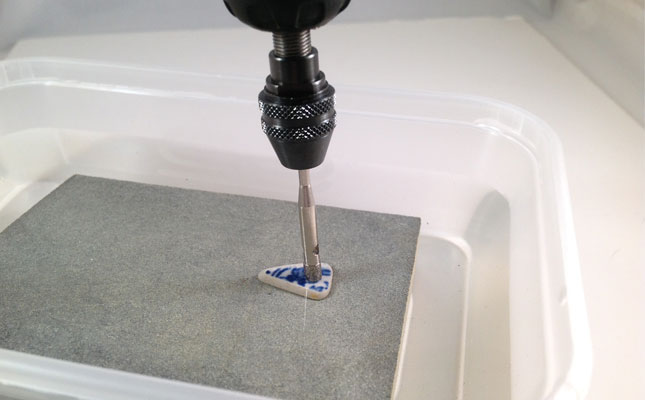
8. How to Start Drilling a Hole in Glass, Stone, Ceramic...
If you're using a drill press or bench press, this won't apply, as you won't be able to angle the drill. However, you can hold your material in place with a vice. If you're using a hand-held Dremel-type drill, flex shaft, pendant drill, cordless drill or handheld rotary tool, read on...
Suppose you have problems with the drill bit skittering across the surface of your material. Angle your drill to start the drilling. Once the initial hole is made, you can drill from a vertical position. This mainly applies to those drilling holes through glass or smooth stone, such as pebbles.
Another option is to use a small piece of masking tape on the area where you wish to start drilling. This will help the drill bit from sliding around; it is very useful for drilling holes through tile or glass bottles. However, this is only applicable when using a larger drill, such as 6mm or larger, not with drill bits as small as 0.75mm to 3mm, for instance.
You may like to take a look at our Infographic on How To Drill Through Glass or How To Drill Sea Glass
Our blog offers numerous easy-to-follow methods for drilling through sea glass and glass bottles, as well as instructions on drilling plates, tiles, ceramic, granite, and mirrors. Additionally, we provide guidance on drilling holes through pebbles, gemstones, and rock. Take a look.
9. Opening Up and Enlarging Holes with Diamond Twist Drills
Diamond twist drills are intended to open up holes rather than create them. They are very popular among bead artists for enlarging the size of holes in beads and are ideal for increasing the size of holes in pearls.
Sizes range from 0.5mm to 3mm.
Tip: Also handy to prevent condensation buildup in the windows of your house. If you're suffering from misted-up double-glazed windows, you can use a 3mm twist drill to make a hole in the inside bottom corner window and the outside top corner window. Follow a suitable tutorial on this before attempting it.
Diamond Ball Burrs are intended for shaping, engraving, carving and grinding. There are videos available showing people using ball burrs to drill holes but they are not intended for this purpose and are not nearly as good as the small diamond drill bits we mention at the start of this article.
Shovel-shaped, spade-shaped, and pointed drill bits are also available for drilling holes in hard materials; however, based on our extensive experience, these options do not perform very well.
10. Can I Drill Tempered Glass?
No. Please do not attempt to drill tempered glass with diamond drill bits; you may end up with cracked glass.
11. Core Drilling Bits. I Want a Core Rather than Drilling a Hole. Is This Possible?
Diamond core drills, despite their name, are primarily intended to create a hole, not to extract a core. However, many artists and scientists use them to extract a core or samples of fossils, let's say for DNA testing, laboratory, geology, optical, and restoration work, and do so with great success.
Some diamond drill bits are specifically designed and manufactured for the purpose of extracting a core.
Thin Wall Diamond Core drills are for drilling precision holes in delicate and thin hard materials such as sheet glass, optical glass, and thin slivers of stone, as well as for extracting a precision core.
When buying core drills, the diameter size listed is the size of the hole you would achieve; therefore, if you are using them to obtain a core, you will usually need to order one or two sizes bigger. Check the technical information on the product page for these specifications.
Mosaic and stained glass artists also use core drills to extract a core, thereby leaving them with a circle of porcelain tile, crockery, china or glass with which to add to their designs.
Jewellers use the drilled-out core as beads. You can file away the underside of the core with a diamond file to make the tiny tile sit flat in your design, or use the file to remove snags and rough edges if you're using them for beading purposes.
Try making seed beads with the core you have left from a 4mm diamond core drill. Once you have extracted the core, use a 1.25mm small diamond drill bit to drill another hole through which to thread your wire.
12. What Speed Should I Use for My Drill Bits?
Use your diamond drill bits at slow speeds, especially when making the initial hole. This will prevent any breakages of your material and help maintain the life of your drill bit. Ideally, aim for a speed not exceeding 10,000 RPM.
The lowest setting on your drill is advisable to use but if you are drilling a hole all the way through your material and you do speed up, take care to make sure you slow down when approaching the exit hole to prevent any cracks forming.
Maintaining a slow speed when drilling will help prevent damage to your material and help to make your drill bits last longer.
------------------------------------------------------------------------------------------
Now you know what to do with your diamond drill bits and how to use them, you have no excuse to start that project you've been meaning to.
Whether you're drilling holes in glass beads, gemstones, or beach pottery, having the right tool makes all the difference. Explore our trusted selection of:
- Precision Solid Diamond Drill Bits for hard, dense materials
- Small Diamond Core Drill Bits for delicate or fragile materials
Get started with the right tool for the job, and make your next project a success.
Disclaimer. To the best of our knowledge, using rotary tools and electric drills near water has never been endorsed by any of the rotary tool manufacturers. If you do choose to drill near water or with attachments under water connected to your drill then you do so at your own risk. Please be aware that mixing electricity and water can be very dangerous.

